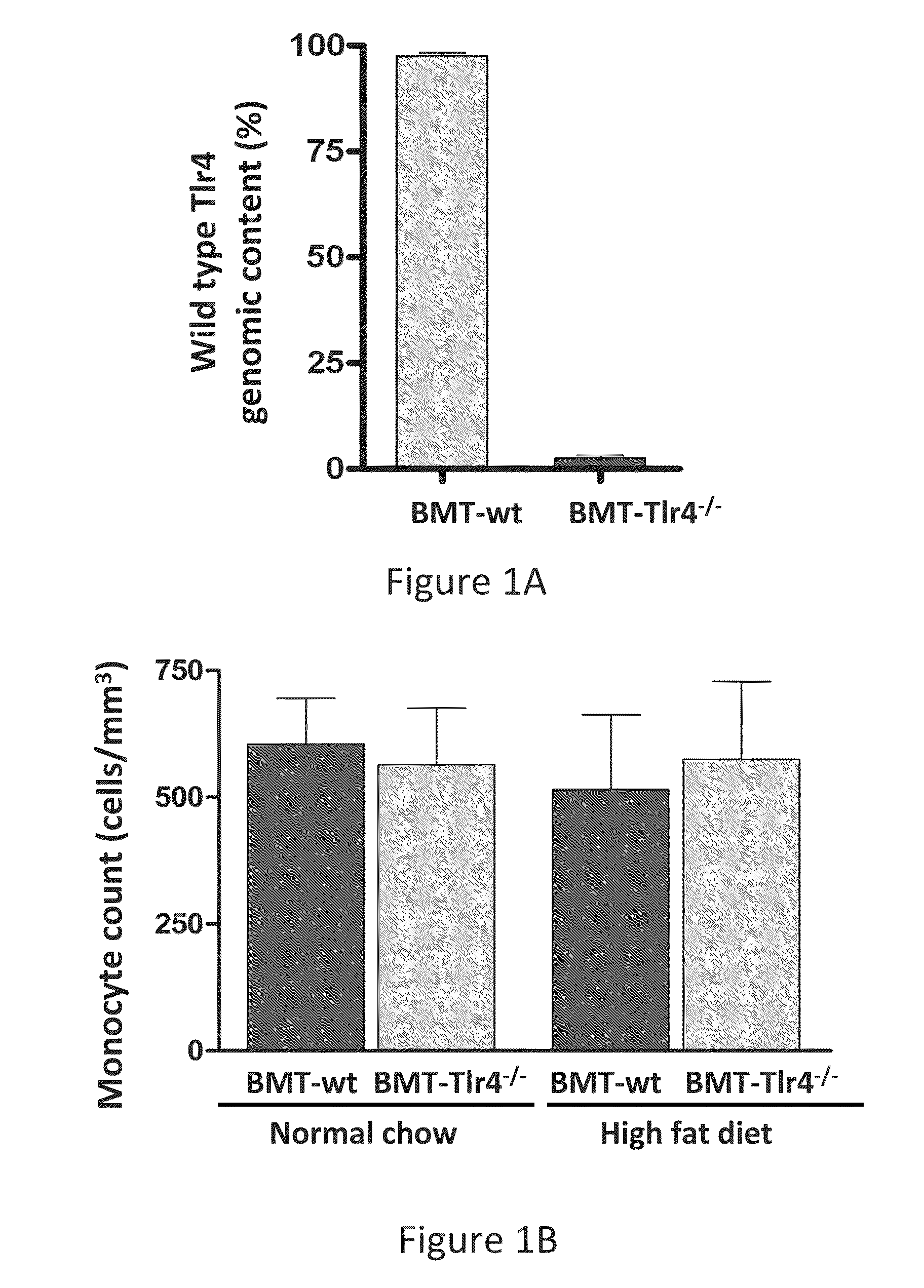Methods and Compositions for Ameliorating Diabetes and Symptoms Thereof
a technology of tlr4 signaling and composition, applied in the field of immunology, can solve the problems of oxidation and storage in muscle, inadequate insulin repression of lipolysis in adipose tissue, and insufficient insulin activation of glucose uptake, etc., to achieve the effect of reducing inflammatory markers, reducing macrophage infiltration, and reducing insulin resistan
- Summary
- Abstract
- Description
- Claims
- Application Information
AI Technical Summary
Benefits of technology
Problems solved by technology
Method used
Image
Examples
example 1
Deletion of Tlr4 Exclusively in Immune Cells Does Not Alter Peripheral Blood Hematopoietic Lineage Distributions
[0069]To generate mice with a complete knockout of Tlr4 in macrophages and other immune cells, irradiated wild type (wt) C57BL6 mice were transplanted with bone marrow from Tlr4Ips.del 15 or wt C57BL / 10J mice. This adoptive transfer approach yielded chimeric mice that were deficient in Tlr4 (BMT-Tlr4− / −) in all hematopoietic derived cells, but which had normal Tlr4 expression in all non-hematopoietic tissues such as skeletal muscle, hepatic tissue, and adipose tissue. Using this technique, eight weeks following bone marrow transplantation (BMT), >95% of white blood cells from BMT-Tlr4− / −mice lacked Tlr4 (FIG. 1A). Mice transplanted with bone marrow from wild type C57BL / 10J mice (BMT-wt) displayed normal Tlr4 expression in all hematopoietic derived cells and non-hematopoietic cells / tissues. The loss of Tlr4 did not alter hematopoietic cell lineage distribution, since monocy...
example 2
Hematopoietic Cell Deletion of Tlr4 Does Not Prevent Obesity, But Ameliorates High-Fat-Dietlobesity-Induced Hyperinsulinemia
[0070]As expected, body weight gain in mice fed a high fat diet (HFD) significantly outpaced mice fed normal chow diet (NCD). There were no significant body weight differences between BMT-wt or BMT-Tlr4− / −mice and no differences in food intake were detected (FIG. 1D and FIG. 1E). In vivo volumetric analysis of body composition using magnetic resonance imaging (MRI) revealed a marked increase in liver size with severe hepatic steatosis, as well as increased visceral adipose deposition in HFD versus NCD mice, irrespective of BMT donor type cells (FIG. 1F). These results demonstrate that the loss of Tlr4 did not affect the ability of mice to become obese; moreover, it did not affect the distribution of fat in the obese animal (FIG. 1G). In contrast, on HFD, body weight gain was markedly reduced in the global Tlr4 knockout mice (i.e. non transplanted mice with knoc...
example 3
Hematopoietic Cell Specific Deletion of Tlr4 Improves Insulin Sensitivity in Liver and Adipose Tissue
[0071]To further quantify whole-body insulin sensitivity and to better delineate the tissue-specific site(s) responsible for the improved glucose homeostasis in BMT-Tlr4− / − mice, hyperinsulinemic-euglycemic clamp studies were performed. With this procedure the measuring of glucose infusion (GINF) rate was required to keep a constant level of blood glucose during a simultaneous infusion of insulin, and the higher the GINF, the greater the overall insulin sensitivity. The clamp results showed that the GINF required to maintain euglycemia (−125 mg / dL) was not significantly different between NCD fed BMT-wt and BMT-Tlr4− / − mice. As expected, BMT-wt mice fed HFD had markedly decreased GINF values, confirming insulin resistance. In contrast, GINF values were ˜70% higher in the HFD BMT-Tlr4− / − mice compared to wt (FIG. 3A) demonstrating partial protection from HFD-induced insulin resistance....
PUM
| Property | Measurement | Unit |
|---|---|---|
| concentrations | aaaaa | aaaaa |
| insulin resistance | aaaaa | aaaaa |
| resistance | aaaaa | aaaaa |
Abstract
Description
Claims
Application Information
 Login to View More
Login to View More - R&D
- Intellectual Property
- Life Sciences
- Materials
- Tech Scout
- Unparalleled Data Quality
- Higher Quality Content
- 60% Fewer Hallucinations
Browse by: Latest US Patents, China's latest patents, Technical Efficacy Thesaurus, Application Domain, Technology Topic, Popular Technical Reports.
© 2025 PatSnap. All rights reserved.Legal|Privacy policy|Modern Slavery Act Transparency Statement|Sitemap|About US| Contact US: help@patsnap.com



